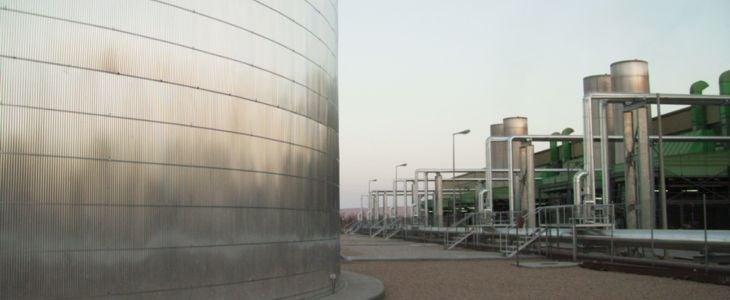Green ammonia has gained attention as a potential solution for decarbonizing the global ammonia industry.
Of the estimated 100 million metric tons of ammonia produced on a global scale, 80% of ammonia is used in agriculture as a fertilizer. In fact, ammonia-based fertilizers are estimated to feed ∼80% of the current world's population.
At the same time, ammonia's significance in the coming decades cannot be overstated. Beyond its crucial role in food production and national security as a key component in nitrogen fertilizers, ammonia is poised to revolutionize the energy landscape.
As a global strive for cleaner energy solutions takes place, ammonia emerges as an extremely versatile player, holding immense potential as an energy carrier. Its applications span from supporting renewable energy integration by acting as a storage medium to serving as a potent maritime fuel and facilitating ammonia refrigeration. All these prospects lead to promising forecasts that anticipate the doubling of demand for ammonia by 2035.
However, such a move towards cleaner energy solutions can only take place through green ammonia. The truth is current ammonia synthesis techniques make it the largest carbon dioxide emitting chemical industry processes, consuming 1.8% of global energy output each year.
This is where the potential for green ammonia stands out. Ammonia itself has zero ozone depletion potential (ODP) and, when produced using green methods, has a significantly lower global warming potential (GWP) compared to conventionally produced ammonia. This means that the adoption of green ammonia could lead to saving over 500 million tonnes of CO2 worldwide each year (almost 2% of global CO2 emissions).
What is green ammonia
Green ammonia refers to ammonia produced using a process that minimizes or eliminates carbon emissions, making it environmentally friendly.
Traditional ammonia production is energy-intensive and often relies on fossil fuels, contributing to greenhouse gas emissions. On the contrary, green ammonia production aims to address this issue by adopting sustainable and low-carbon technologies.
The conventional way for obtaining ammonia relies on the Haber-Bosch process, which uses natural gas as a feedstock and is extremely energy-intensive, demanding significant energy input, often derived from non-renewable sources. In fact, ammonia synthesis generates 2 to 2.5 tons of CO2 for every ton of product (being more carbon-intensive than steel or cement).
The combustion of natural gas releases carbon dioxide (CO2) into the atmosphere. But that’s not all: this method of producing ammonia also involves direct emissions of nitrous oxide (N2O), a potent greenhouse gas.
This leads to concerning results around the traditional synthesis of ammonia, which is responsible for approximately 1.8% of the world’s carbon dioxide emissions (according to a policy briefing from The Royal Society).
Green ammonia moves away from fossil fuels by adopting electrolysis: electricity is used to split water into hydrogen and oxygen; then, the now green hydrogen is combined with nitrogen to form green ammonia.
Additionally, some cutting-edge green ammonia production processes incorporate carbon capture and utilization technologies to further reduce emissions.
The potential and uses of green ammonia
Green ammonia can become a great ally to face climate change, guaranteeing a sustainable provision of this much demanded chemical.
The following are some of the areas where the potential of green ammonia is expected to be a revolutionary force:
Renewable energy storage
Ammonia can be utilized as a carrier for hydrogen, enabling the storage and transport of renewable energy and helping in the overcoming of the intermittent nature of renewable sources like solar and wind power.

At the same time, green ammonia exhibits excellent energy storage characteristics, boasting a high volumetric energy density relative to hydrogen. While its energy density is comparable to that of fossil fuels, it possesses the advantage of being easily liquefiable, and the raw materials required for its production are abundant.
As such, green ammonia can play a crucial role in facilitating a convenient transportation and storage, also benefiting from an already established global distribution infrastructure including vessels, pipelines, and road tankers, among other means.
Hydrogen energy vector
The ammonia infrastructure is often seen as a catalyst to kick-start the hydrogen economy. While green hydrogen is difficult and expensive to store in bulk (needing cryogenic tanks or high-pressure cylinders), ammonia is easier and cheaper to store and transport.
Green ammonia becoming a hydrogen source for cleaner industrial processes means it could support a crucial shift towards cleaner and more sustainable manufacturing methods, and enable the benefits aligned with the use of hydrogen.
Fuel for transportation
The by-products of burning green ammonia are water and nitrogen. As such, ammonia has the potential to be used as a clean and sustainable fuel for maritime transport, reducing the carbon footprint of shipping activities. In fact, ammonia-compatible engines could be ready as early as 2024.
Green fertilizer production
The use of green ammonia in fertilizer production is expected to contribute to an increasingly sustainable agriculture sector. Because green ammonia is produced using renewable energy sources, it significantly lowers its carbon footprint compared to conventional ammonia production methods. It’s also worth noting that traditional ammonia production methods often result in the release of nitrous oxide, a potent greenhouse gas.
On the contrary, green ammonia, produced through cleaner processes, helps minimize these emissions and contributes to a more environmentally friendly fertilizer production cycle. This new breed of sustainable fertilizers could potentially contribute to improved soil health, as well as appealing to environmentally-conscious consumers.
Greener heating and cooling
The use of green ammonia for refrigeration can provide several environmental benefits compared to conventional refrigeration systems.
Ammonia-based heat pumps can be developed for heating and cooling applications in residential and industrial settings. It’s also being explored as a sustainable refrigerant for refrigeration systems, offering an eco-friendly alternative to synthetic refrigerants.
This has led to the development of what is labeled as ammonia refrigeration, an approach to industrial refrigeration that uses ammonia as a refrigerant. The use of ammonia as a refrigerant is, in fact, not new: this chemical was one of the earliest refrigerants, replaced by chlorofluorocarbons (CFCs) in the 1920s. However, as restrictions on polluting refrigerants arise and more sustainable alternatives are demanded, green ammonia is now being hailed as an optimal solution. This is thanks to some of the most remarkable advantages of ammonia refrigeration, including:
- Outstanding thermodynamic properties, which mean ammonia is able to absorb large amounts of heat during evaporation
- Great refrigeration efficiencies, so that ammonia can be up to 20% more efficient than other industrial refrigeration alternatives at full capacity
- Environmentally-friendly, with zero ozone depletion potential (ODP) and a low global warming potential (GWP)
- Low cost (one tenth of some conventional hydrofluorocarbon refrigerants)
Wide operating range for numerous cooling requirements.

At ARANER, we stand at the forefront of innovation, leading the charge in transforming industries towards sustainable practices by spearheading the creation of green ammonia.
Through our cutting-edge expertise in designing and implementing thermal energy technologies, Araner empowers companies to make significant strides in environmental responsibility with the seamless integration of state-of-the-art solutions that pave the way for the production of green ammonia.
By leveraging our engineering prowess, at Araner we’re both catalysts and allies for change, enabling businesses to adopt eco-friendly alternatives and contribute to a cleaner, greener future.
With a focus on sustainability and a track record of successful implementations, we’re committed to becoming a driving force behind the global shift towards a more environmentally conscious and responsible industrial landscape.
As such, our portfolio of cooling and heating technologies is now enabling the transition towards the production of various cutting-edge clean energy solutions, from green hydrogen to green ammonia.
We offer efficient chillers for cooling electrolytes, hydrogen, oxygen, nitrogen and ammonia through various sustainable methods and technologies. From using sea or river water to produce green hydrogen to cooling systems able to reduce the heat released by condensation systems, as well as implementing means to reuse waste heat from different sources to optimize the cooling process or the opportunity to store thermal energy.
Through our expertly-designed ammonia chiller systems, we help you elevate your facility's cooling capabilities. Our expert professionals bring a wealth of experience in the realm of ammonia refrigeration systems and green ammonia, ensuring a seamless journey from evaluation to design, and all the way to the safe and efficient operation and maintenance of your facility.
As using incompatible materials anywhere in the system is not just a risk, but a potential hazard, our meticulous design approach guarantees true safety while also developing a sophisticated and secure ammonia refrigeration system tailored to elevate your project to new heights of efficiency and safety.
With decades-long expertise in energy and cooling engineering, we’re now paving the way for cutting-edge industrial refrigeration and the production of green ammonia. Want to learn more about our work? Get in touch with us and speak to our team about how we can help you achieve sustainable and cost-efficient green ammonia production.










